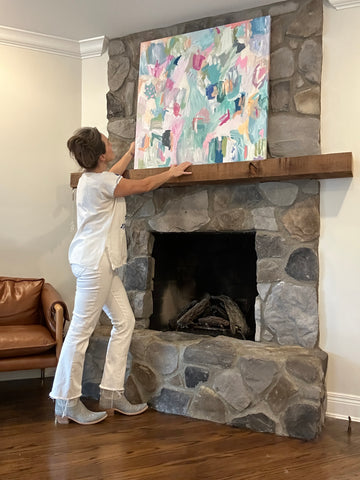
How to Hang Abstract Art on your walls
Share
Hanging Abstract Art: A Guide to Bringing the WOW Factor to Your Space
Abstract art, with its bold colors, dynamic shapes, and layered textures, can add a unique and captivating element to your home. But unlike representational art, where placement is often guided by the subject matter, hanging abstract pieces requires a more thoughtful approach. Here's a comprehensive guide to help you showcase your abstract painting in its full glory:
Before You Begin:
- Consider the artwork: Analyze the size, weight, and material of the painting. Larger pieces require sturdier hanging mechanisms and may need additional support. Knowing the material helps choose appropriate hardware.
- Evaluate the space: Assess the wall size, furniture arrangement, and lighting conditions. Consider the desired focal point and how the artwork will interact with the surrounding elements.
-
Prepare your tools: Gather essential tools like a measuring tape, level, stud finder, hammer, drill (if needed), picture hanging kit, and pencil.

Finding the Perfect Placement:
- Eye level is key: Aim for the center of the artwork to be approximately 56-60 inches from the floor. This is a comfortable viewing height for most individuals.
- Embrace experimentation: Unlike representational art, abstract pieces offer more flexibility in orientation. Experiment with hanging the painting horizontally or vertically to see which orientation resonates best within the space.
- Consider the "conversation": If hanging multiple abstract pieces, arrange them in a way that feels cohesive and visually engaging. Group them by color palette, theme, or size for a curated look.
-
Balance and proportion: Ensure the artwork complements the scale of the wall and surrounding furniture. Avoid overwhelming a small space with a large piece or placing a small painting on a vast expanse of wall.

Creative Hanging Techniques:
- Gallery wall: Create a dynamic display by grouping several abstract pieces of varying sizes and styles. Arrange them in a symmetrical or asymmetrical pattern, leaving ample space between each piece for visual breathing room.
- Off-center placement: Break away from conventional center alignment and hang the artwork slightly off-center to create a sense of intrigue and dynamism. This technique can be particularly effective in hallways or above doorways.
-
Layering: Experiment with layering smaller abstract pieces on top of larger ones, creating a visually layered and textured composition. Ensure the colors and shapes complement each other for a harmonious effect.

Choosing the Right Hardware:
- For lightweight pieces: D-rings and picture hanging wire are sufficient. Ensure the wire is securely attached to the D-rings and the appropriate picture hooks are mounted on the wall.
- For heavier pieces: Opt for heavy-duty hangers or french cleats that can support the weight of the artwork. Follow the manufacturer's instructions for proper installation.
- Consider professional installation: For valuable or particularly heavy pieces, seeking assistance from a professional art installer is recommended to ensure proper hanging and safety.
Additional Tips:
- Lighting matters: Position the artwork where it receives good natural light or use appropriate artificial lighting to highlight its colors and textures. Avoid placing the artwork directly opposite a window to prevent glare.
- Mind the background: Choose a wall color that complements the artwork without overpowering it. Neutral colors like white, beige, or light gray often provide a versatile backdrop for abstract pieces.
- Trust your intuition: Ultimately, the best way to hang your abstract art is to follow your personal taste and experiment until you find a placement that feels harmonious and visually pleasing to you.
- HAVE FUN! The process of finding the right art that speaks to you is a journey, enjoy it!
